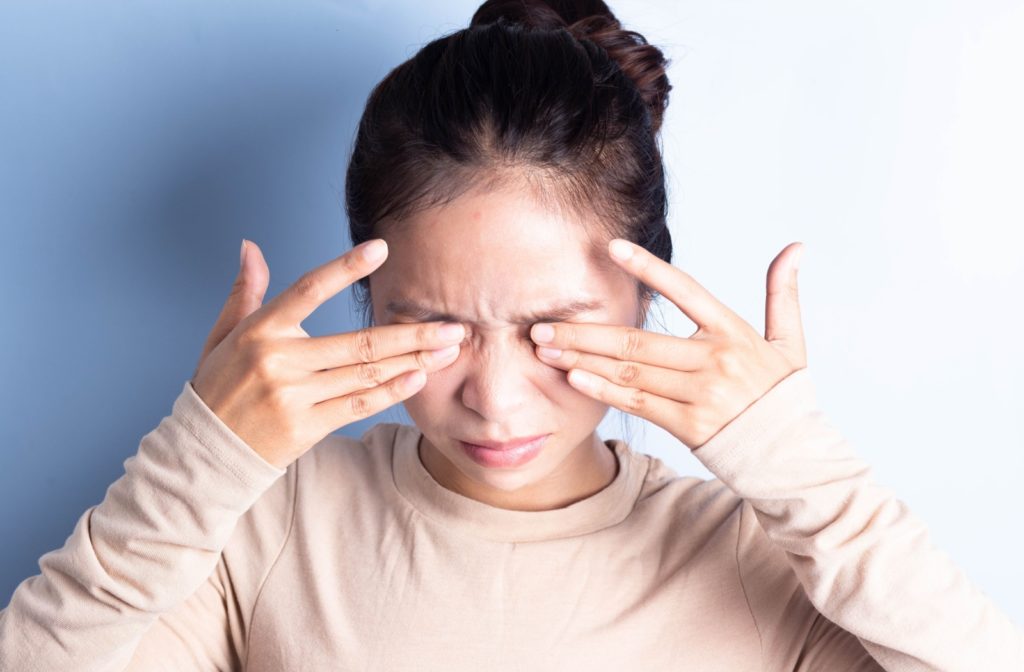Feeling pressure in your eye can be unsettling, leaving you searching for answers. Is it from staring at screens too long, a sign of something serious, or just fatigue?
A number of factors can contribute to feeling pressure in your eyeball, including:
- Eye strain
- Dry eyes
- Sinus pressure
- Glaucoma
- Migraines
- Eye infection or injury
- High blood pressure or stress
What Does “Pressure in the Eye” Feel Like?
Eye pressure can manifest in several ways. Some describe it as a sensation of fullness or heaviness within the eyeball. Others experience a dull discomfort around the entire eye or a feeling of strain, especially when focusing for prolonged periods.
Unlike internal eye pain, eye pressure is usually mild but persistent. Identifying these sensations and when they occur is a key step in determining potential causes.
Common signs of eye pressure include:
- A tight or heavy sensation in or around the eyes
- Blurry or hazy vision
- Mild headache centered behind the eye
- Occasional sensitivity to light
If this sounds familiar, contact your eye doctor for a comprehensive eye exam. Several minor or major factors might be at play.
What Causes Eye Pressure?
Eye pressure can be caused by various factors, ranging from harmless lifestyle habits to underlying medical conditions. Here’s a closer look at some of the most common causes.
1. Eye Strain (Digital Eye Strain)
With the rise of cellphone screens and laptops, digital eye strain has become one of the leading culprits of that heavy, strained feeling. Long hours staring at a screen cause your eyes to struggle with blue light, constant focusing, and reduced blinking.
Signs it’s digital eye strain:
- Tension around the eyes
- Headaches
- Blurred vision
How to manage it:
- Follow the 20-20-20 rule—every 20 minutes, take a 20-second break to look at something 20 feet away
- Adjust the brightness and distance of your screen
- Consider investing in blue light-blocking glasses
2. Sinus Pressure
Your sinuses and eyes are closely connected. When your sinuses are inflamed or blocked (often from allergies or a sinus infection), they can create pressure that radiates to your eyeballs.
Signs it’s sinus-related:
- Pressure around your cheeks, forehead, or between your eyes, often accompanied by nasal congestion or tenderness in the face
How to manage it:
- Over-the-counter decongestants may ease symptoms
- A humidifier can soothe dry nasal passages
If the problem persists, visit a doctor to rule out a severe infection.
3. Dry Eye Syndrome
When your eyes don’t produce enough tears or produce poor-quality tears, it can cause dryness and discomfort that mimics or contributes to eye pressure.
Signs it’s dry eye syndrome:
- A gritty sensation as if there’s sand in your eyes
- Sensitivity to light
- Occasional eye redness
How to manage it:
- Use artificial tears to lubricate your eyes
- Avoid windy or air-conditioned environments that worsen dryness
- Visit your eye doctor for dry eye treatment
4. Glaucoma
While often asymptomatic in its early stages, glaucoma is one of the more serious conditions associated with increased eye pressure. High intraocular pressure due to improper fluid drainage in the eye can damage the optic nerve, potentially leading to vision loss if untreated.
Signs it could be glaucoma:
- No symptoms at first
- Blind spots
- Tunnel vision
- Seeing halos around lights
If you suspect glaucoma, schedule an eye exam immediately. Early detection can prevent vision loss. Regular eye exams can help catch signs before symptoms arise.
5. Migraine or Cluster Headaches
Migraines and cluster headaches often result in referred pain, which feels like pressure or discomfort around one or both eyes.
Signs it’s headache-related:
- Pulsing or throbbing pain
- Nausea
- Sensitivity to light
- Visual disturbances
How to manage it:
- Identify and avoid headache triggers (e.g., stress, lack of sleep, certain foods)
- Over-the-counter or prescription medications
6. Eye Infection or Injury
Eye pressure could also be the result of conjunctivitis (pink eye) or an undiagnosed eye injury.
Signs of infection or injury:
- Redness
- Swelling
- Discharge
- Sharp pain
Visit your eye doctor promptly. Delaying treatment for infections or injuries can lead to further complications.
7. High Blood Pressure or Stress
Both hypertension and stress can have surprising effects on your body, including the eyes. High blood pressure or heightened stress might increase sensitivity and tension in your ocular nerves.
Signs it could be stress or blood pressure-related:
- Headaches
- Consistent fluttering or twitching around the eyes
- Overall fatigue
How to manage it:
- Practice relaxation techniques like yoga, meditation, or deep breathing
- Monitor and manage your blood pressure with regular checkups

When to See an Eye Doctor
While some causes of eye pressure are mild and temporary, others may require professional evaluation. It’s always better to err on the side of caution when it comes to your vision.
Signs for when to visit us:
- Persistent eye pressure lasting several days
- Sudden or severe pain in or around the eye
- Changes in vision, such as blurriness, blind spots, or difficulty focusing
- Swelling, redness, or unusual discharge
Not only can we help determine the cause of your symptoms, but we can also help rule out more serious conditions you may not be aware of.
Your Vision Matters—Take the Next Step
Feeling pressure in your eye can range from annoying to alarming, but understanding potential causes is the first step toward relief. If your symptoms persist or worsen, don’t ignore them.
Book an eye exam today and find peace of mind knowing your vision is in good hands at Total Vision Richmond.


